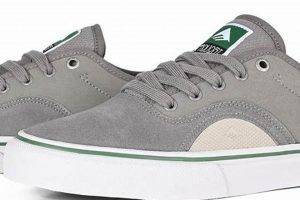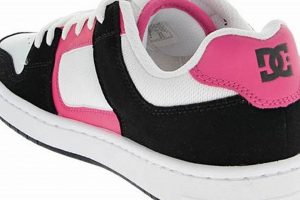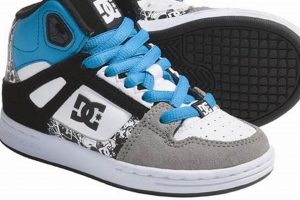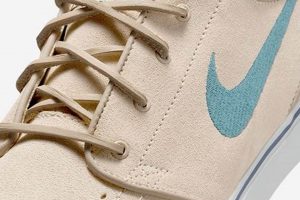Footwear designed specifically for skateboarding activities, typically featuring durable construction, reinforced stitching, and a flat, grippy sole for optimal board control, can be understood as equipment facilitating movement and providing protection during complex maneuvers. These products often incorporate design elements that reflect current trends and cater to the aesthetic preferences of the skateboarding community, while prioritizing performance and longevity under demanding conditions.
The selection of appropriate gear significantly impacts a skater’s ability to execute tricks, maintain balance, and prevent injuries. The development of specialized gear has paralleled the evolution of skateboarding, with manufacturers continually innovating to meet the changing demands of the sport. Considerations such as cushioning, ankle support, and abrasion resistance are paramount in product design, contributing to enhanced rider confidence and overall skill progression.
The subsequent sections will delve into the specific features, benefits, and styles associated with various offerings, including their impact on performance and suitability for different skateboarding disciplines. This exploration will provide a nuanced understanding of the factors to consider when selecting suitable gear for this activity.
This section provides guidance on selecting appropriate skateboarding footwear, focusing on factors that enhance performance and durability. Careful consideration of these aspects can significantly impact a skater’s experience and longevity in the sport.
Tip 1: Prioritize Sole Adhesion: The sole’s grip is paramount. Look for vulcanized rubber or cupsole constructions with deep tread patterns. A secure connection between the shoe and the skateboard is essential for control during ollies and other maneuvers. For instance, examine the outsole for a waffle-like pattern, which typically indicates enhanced grip.
Tip 2: Evaluate Upper Material Durability: Canvas and suede are common choices, each offering different advantages. Suede is more abrasion-resistant, better suited to frequent use. Canvas is generally more breathable, which is ideal for warmer climates or extended sessions. Double-stitching and reinforced ollie patches extend the lifespan of the upper.
Tip 3: Consider Padding and Support: Adequate padding around the ankle collar and tongue is essential for impact absorption and comfort. Higher-cut models provide increased ankle support, reducing the risk of sprains. Evaluate the insole material; polyurethane insoles offer better cushioning and support than basic foam.
Tip 4: Assess Stitching Quality: Examine the stitching along the seams and high-stress areas. Double or triple stitching enhances the shoe’s structural integrity and prevents premature wear and tear. A poorly stitched shoe will likely fail under the rigors of skateboarding.
Tip 5: Evaluate Midsole Construction: The midsole provides cushioning and impact absorption. Look for models with EVA (Ethylene-vinyl acetate) midsoles, which offer a balance of cushioning and board feel. Softer midsoles provide more impact protection but may compromise board feel.
Tip 6: Inspect the Lacing System: Recessed or reinforced eyelets prevent lace breakage. Consider models with lace protection systems, such as hidden lacing or reinforced panels, to minimize wear and tear on the laces. Broken laces can disrupt a session and necessitate replacement.
Careful attention to these details will contribute to a more comfortable, durable, and performance-oriented skateboarding experience. Choosing footwear that aligns with individual skating style and preferences will ultimately enhance skill progression and enjoyment of the sport.
The following sections will address common issues and maintenance practices related to skateboarding footwear, ensuring prolonged usability and optimal performance.
1. Durability
Durability is a paramount characteristic in skateboarding footwear, directly influencing its lifespan and the skater’s ability to perform consistently. Footwear endures significant abrasion and impact during skateboarding activities. Therefore, materials, construction techniques, and design elements must prioritize resistance to wear and tear. The cause-and-effect relationship is clear: Substandard durability results in premature failure of the footwear, necessitating frequent replacement and potentially compromising the skater’s safety. The importance of durability is underscored by the demanding nature of skateboarding, where repetitive motions, harsh surfaces, and forceful landings exert considerable stress on the footwear. For instance, ollie patches and reinforced stitching are common features aimed at mitigating wear in high-stress areas, reflecting a direct response to observed patterns of damage.
The practical significance of understanding durability in skateboarding footwear extends beyond mere cost savings. Durable footwear provides a more stable and reliable platform for executing tricks and maneuvers. A shoe that retains its shape and structural integrity over time allows the skater to maintain a consistent feel and control over the board. Furthermore, durable footwear reduces the risk of injury by providing consistent support and protection. Examples of durable skateboarding footwear often incorporate high-quality suede or leather uppers, double or triple stitching in critical areas, and robust outsole construction. These features contribute to enhanced resistance against abrasion, impact, and tearing, ensuring that the footwear withstands the rigors of skateboarding for an extended period.
In summary, durability is a foundational attribute of skateboarding footwear, directly impacting performance, safety, and cost-effectiveness. The selection of durable materials, the implementation of reinforced construction techniques, and the incorporation of design elements that address specific wear patterns are crucial for ensuring that the footwear meets the demands of skateboarding. By prioritizing durability, skaters can minimize the risk of injury, maintain consistent performance, and reduce the frequency of footwear replacement, ultimately contributing to a more enjoyable and sustainable skateboarding experience.
2. Grip
The coefficient of friction between the outsole of skateboarding footwear and the skateboard deck is a critical determinant of performance. Secure grip facilitates board control, enabling execution of complex maneuvers and providing stability during landings. The relationship between grip and performance is one of direct causation; insufficient grip results in slippage, compromising control and increasing the risk of injury. The importance of grip as a component of skateboarding footwear is underscored by its direct impact on the skater’s ability to maintain contact with the board and effectively manipulate its movement. The formulation and tread pattern of the outsole material are crucial determinants of grip effectiveness. For example, vulcanized rubber compounds and waffle-pattern treads are commonly employed to maximize surface area contact and enhance friction.
Variations in grip characteristics can significantly affect a skater’s style and preferences. For instance, some skaters favor softer rubber compounds for increased grip on smooth surfaces, while others prefer harder compounds for enhanced durability on rough terrain. The selection of appropriate grip characteristics is often influenced by the skater’s discipline, with street skaters typically prioritizing durability and park skaters emphasizing responsiveness and board feel. Practical application of this understanding involves careful evaluation of outsole materials and tread patterns based on intended use and surface conditions. Furthermore, maintaining clean outsoles is essential for preserving optimal grip; dirt and debris can significantly reduce friction and compromise performance.
In summary, the effectiveness of the grip on skateboarding footwear directly influences a skater’s ability to control the board and execute maneuvers safely and effectively. Outsole material, tread pattern, and maintenance practices are all critical factors that contribute to grip performance. Understanding the relationship between these elements is essential for selecting appropriate footwear and optimizing performance within the context of skateboarding. Challenges associated with maintaining optimal grip include dealing with varying surface conditions and the gradual degradation of outsole materials over time. Continued innovation in outsole technology remains a crucial area of focus for improving the performance and safety of skateboarding footwear.
3. Impact Absorption
The capacity of skateboarding footwear to attenuate forces generated during landings and other high-impact maneuvers constitutes a critical performance parameter. Adequate impact absorption mitigates stress on joints, reducing the risk of injuries such as ankle sprains, heel bruises, and knee problems. The design and materials employed in the midsole and insole directly influence the degree of impact protection afforded. A deficiency in impact absorption can lead to chronic pain and potentially limit a skater’s ability to progress. The relevance of impact absorption is particularly pronounced in skateboarding given the frequency of jumps, drops, and other aerial maneuvers, where forces exerted upon landing can exceed several times the skater’s body weight. Footwear incorporating features such as gel inserts, air pockets, or specialized foam compounds exemplify design strategies aimed at enhancing impact attenuation.
Assessment of impact absorption characteristics should consider the skater’s weight, skill level, and preferred skateboarding discipline. Skaters engaging in high-impact activities, such as vert or park skating, require footwear with superior cushioning compared to those primarily focused on flat ground tricks. The material properties of the midsole play a pivotal role, with materials like EVA (ethylene-vinyl acetate) offering a balance of cushioning and board feel. Insole design can further augment impact absorption, with contoured footbeds and arch support contributing to improved shock distribution. Practical application of these principles involves selecting footwear that aligns with individual needs and skating style. Regular replacement of insoles can also maintain optimal impact absorption over time, as cushioning materials tend to degrade with use. Furthermore, incorporating warm-up and stretching routines can complement the protective function of skateboarding footwear, preparing the body for the stresses of the activity.
In summary, impact absorption is an essential attribute of skateboarding footwear, directly influencing injury prevention and overall performance. Material selection, midsole design, and insole characteristics all contribute to the footwear’s ability to attenuate forces generated during skateboarding activities. Understanding these relationships enables skaters to make informed decisions regarding footwear selection, thereby minimizing the risk of injury and maximizing their potential for skill development. Future advancements in materials science and footwear design hold promise for further enhancing impact absorption capabilities, ultimately contributing to a safer and more enjoyable skateboarding experience.
4. Board Feel
Board feel, a subjective but critical aspect of skateboarding footwear, describes the skater’s ability to sense the nuances of the skateboard beneath their feet. It directly influences control, precision, and the overall connection between the skater and the board. The design and construction of skateboarding shoes significantly impact this sensation; variations in sole thickness, midsole material, and overall flexibility contribute to the level of board feel experienced.
- Sole Thickness and Flexibility
A thinner sole generally enhances board feel, allowing the skater to perceive subtle changes in the board’s angle and pressure distribution. However, reduced sole thickness can compromise impact protection. The flexibility of the sole also plays a role, enabling the skater to conform to the board’s curvature and maintain consistent contact. Example: A vulcanized sole tends to offer a balance of flexibility and durability, contributing to enhanced board feel without sacrificing robustness.
- Midsole Material and Construction
The midsole provides cushioning and shock absorption, but its composition can influence board feel. A dense, rigid midsole may dampen sensation, while a softer, more pliable material can enhance it. The absence of a midsole altogether results in direct contact with the board, maximizing board feel but minimizing impact protection. Example: Certain skateboarding shoes feature removable or customizable insoles, allowing skaters to fine-tune the balance between board feel and cushioning to suit their preferences.
- Upper Construction and Fit
The upper construction contributes indirectly to board feel by influencing the overall fit and stability of the shoe. A snug, secure fit enhances the skater’s sense of control and prevents unwanted movement within the shoe, allowing for more precise board manipulation. The materials used in the upper can also affect breathability and flexibility, indirectly impacting the skater’s comfort and performance. Example: Skateboarding shoes with minimal padding in the upper offer a closer fit and enhanced board feel, while those with more substantial padding prioritize comfort and impact protection.
- Outsole Pattern and Grip
While primarily associated with traction, the outsole pattern can also contribute to board feel by providing a tactile interface between the shoe and the board. A well-designed outsole pattern ensures consistent contact and prevents slippage, allowing the skater to feel confident and in control. The material properties of the outsole also play a role, with softer rubber compounds offering enhanced grip and board feel but potentially sacrificing durability. Example: Waffle-pattern outsoles are commonly used in skateboarding shoes for their combination of grip and flexibility, providing a balance between board feel and traction.
Board feel, in the context of skateboarding footwear, represents a crucial intersection of design, materials, and skater preference. The interplay between sole thickness, midsole composition, upper construction, and outsole pattern determines the level of tactile feedback experienced by the skater. These factors collectively contribute to the overall sense of control, precision, and connection with the board, ultimately influencing performance and enjoyment of the sport.
5. Ankle Support
Ankle support in skateboarding footwear is a critical feature directly influencing skater safety and performance. The repetitive stress and impact inherent in skateboarding maneuvers subject the ankle joint to significant strain. Footwear designed with adequate ankle support aims to mitigate the risk of sprains, fractures, and other lower extremity injuries. The cause-and-effect relationship is evident: insufficient ankle support increases vulnerability to injury, while robust support enhances stability and reduces the likelihood of trauma. Skateboarding-related ankle injuries can result in prolonged recovery periods, hindering skill progression and participation in the sport. Therefore, the provision of adequate ankle support is an essential consideration in footwear design. The presence of high-top designs, padded collars, and reinforced heel counters are indicative of design efforts to enhance ankle stability. These features work in concert to limit excessive ankle movement, providing a secure and supportive environment for the foot.
Examining specific skateboarding shoe designs reveals varying approaches to ankle support. Some models prioritize flexibility and board feel, offering minimal ankle support to maximize freedom of movement. Conversely, other models emphasize stability and protection, incorporating rigid support structures and substantial padding around the ankle. The selection of appropriate ankle support depends on individual skater preferences, skill level, and the type of skateboarding activities undertaken. Skaters engaging in high-impact activities, such as vert or park skating, typically benefit from footwear with enhanced ankle support. A practical approach involves evaluating shoe designs based on their intended use and personal injury history. Furthermore, the fit of the shoe is critical; a properly fitted shoe will provide optimal support and minimize the risk of slippage or instability. Lacing systems that extend higher up the ankle can also contribute to enhanced support.
In summary, ankle support is a key determinant of safety and performance in skateboarding footwear. Adequate support reduces the risk of injury, while insufficient support increases vulnerability to ankle-related trauma. The selection of appropriate ankle support should consider individual skating style, skill level, and personal injury history. Design features such as high-top designs, padded collars, and reinforced heel counters contribute to enhanced ankle stability. While no shoe can eliminate the risk of injury entirely, prioritizing ankle support can significantly mitigate the likelihood of lower extremity trauma. Further research into biomechanics and footwear design may lead to future innovations in ankle support technology, ultimately contributing to a safer and more enjoyable skateboarding experience. Understanding that different models provide different level of support is a key aspect for the user.
6. Style
The aesthetic design of skateboarding footwear, often referred to as style, constitutes a significant factor influencing consumer choice and brand identity. Footwear functions not only as a protective element but also as an expression of personal identity and affiliation within the skateboarding subculture. Therefore, stylistic considerations are intricately linked to the perceived value and marketability of such products. The cause-and-effect relationship is evident: aesthetically pleasing designs command greater consumer interest, while visually unappealing products face diminished market prospects. The importance of style as a component of skateboarding footwear arises from the deeply ingrained cultural associations surrounding the sport, where personal expression and individuality are highly valued. For instance, variations in color schemes, graphic embellishments, and silhouette designs serve to differentiate products and appeal to diverse skater preferences. A real-life example is observed in the adoption of specific colorways or collaborations with artists and skateboarders to create limited-edition products, capitalizing on the appeal of exclusivity and cultural relevance. Understanding this connection is practically significant for manufacturers seeking to establish brand recognition and capture market share.
Further analysis reveals a correlation between specific stylistic trends and skateboarding subcultures. The evolution of skate shoe design mirrors the broader trends in fashion and street culture, incorporating elements such as retro aesthetics, minimalist designs, and technical innovations. For instance, the resurgence of vulcanized soles and classic silhouettes reflects a renewed appreciation for skateboarding’s heritage, while the incorporation of advanced materials and streamlined designs caters to skaters seeking performance-oriented footwear. Practical applications of this understanding involve market research and trend analysis to identify emerging stylistic preferences and adapt product offerings accordingly. Manufacturers may also leverage social media and influencer marketing to promote stylistic aspects of their products, targeting specific demographics within the skateboarding community. Example of this include the usage of muted tones and simple designs or vibrant colors to promote energy.
In summary, style serves as a vital component of skateboarding footwear, influencing consumer choice, brand identity, and cultural expression. Aesthetically pleasing designs command greater consumer interest, while also playing into performance features. Manufacturers must consider stylistic trends, cultural associations, and skater preferences to develop products that resonate with their target audience. Challenges associated with stylistic design include balancing aesthetic appeal with functional requirements and adapting to evolving trends. The broader theme of style in skateboarding footwear underscores the importance of understanding cultural context and consumer behavior in product development and marketing. Brand image and consumer perception go hand-in-hand.
7. Construction Materials
The performance and durability of footwear designed for skateboarding are intrinsically linked to the materials employed in their construction. The inherent stress imposed on skateboarding shoes during activities necessitates the utilization of robust and abrasion-resistant components. Inadequate material selection directly correlates with premature wear, reduced performance, and potential safety hazards. Therefore, construction materials are a pivotal aspect of skateboarding shoe design. The selection of materials such as suede, canvas, leather, rubber, and specialized synthetics reflects a deliberate strategy to optimize performance characteristics. For instance, suede uppers offer enhanced abrasion resistance, while vulcanized rubber outsoles provide superior grip and board feel. The implementation of reinforced stitching and ollie pads further demonstrates the significance of material selection in withstanding the rigors of skateboarding. Specific examples would include models utilizing ballistic nylon for increased tear resistance or incorporating memory foam in the insole for enhanced impact absorption.
Further examination reveals a nuanced relationship between material properties and skateboarding style. Certain materials offer distinct advantages for specific types of skateboarding. Cupsole construction, for example, often employs a thicker rubber sole for enhanced impact protection, favored by skaters engaging in vert or park riding. Conversely, vulcanized construction utilizes a thinner, more flexible sole, providing greater board feel and control, appealing to street skaters. The practical application of this understanding involves assessing the skater’s intended use and selecting footwear accordingly. Footwear featuring breathable mesh panels may be advantageous in warmer climates, while waterproof treatments are beneficial in wet conditions. Similarly, the density and composition of midsole materials influence cushioning and shock absorption, impacting overall comfort and performance. Brands like Ecko, within their skateboarding shoe lines, make decisions about material pairings depending on the cost vs perfomance they want to aim for.
In summary, the construction materials used in skateboarding footwear are a key determinant of durability, performance, and safety. Careful consideration of material properties is essential for optimizing the shoe’s ability to withstand the demands of skateboarding. Challenges associated with material selection include balancing performance characteristics with cost constraints and addressing evolving skater preferences. Understanding the relationship between materials and skateboarding style allows for informed purchasing decisions and ultimately contributes to a more enjoyable and sustainable skateboarding experience. A key element is recognizing the trade offs for each material decision.
Frequently Asked Questions Regarding Ecko Skate Shoes
This section addresses common inquiries and concerns regarding Ecko skate shoes, providing factual information to aid in informed decision-making.
Question 1: Are Ecko skate shoes suitable for professional skateboarding?
Ecko skate shoes are often designed for recreational and lifestyle use. Performance in professional skateboarding depends heavily on specific model features, durability, and individual preferences. Assess technical specifications before use in professional contexts.
Question 2: What materials are commonly used in Ecko skate shoe construction?
Ecko skate shoes typically incorporate a range of materials, including suede, canvas, leather, and synthetic fabrics. Outsoles are often constructed from vulcanized rubber or cupsole rubber compounds. Specific material composition varies by model.
Question 3: How should Ecko skate shoes be cleaned and maintained?
Cleaning methods depend on the materials. Suede shoes require specialized brushes and cleaners. Canvas and synthetic shoes can often be cleaned with mild soap and water. Avoid harsh chemicals and excessive moisture. Regular cleaning extends shoe lifespan.
Question 4: Do Ecko skate shoes offer adequate ankle support for skateboarding?
Ankle support varies between Ecko skate shoe models. High-top designs generally provide more support than low-top designs. Consider individual needs and skating style when selecting a model. Additional aftermarket insoles can enhance support.
Question 5: Are Ecko skate shoes durable enough for regular skateboarding?
Durability depends on the specific model and skating intensity. Models with reinforced stitching, ollie pads, and durable materials are generally more resilient. Inspect shoes regularly for wear and tear. Frequent skateboarding accelerates wear.
Question 6: Where can one purchase Ecko skate shoes?
Ecko skate shoes are available at select retailers, both online and in physical stores. Availability may vary depending on location and model. Check authorized retailers to ensure authenticity and warranty coverage. Certain models may be discontinued.
The information provided is intended to address common concerns. Individual experiences may vary. Consult product specifications and reviews for detailed information.
The following section explores maintenance practices to prolong the lifespan of skateboarding footwear.
Ecko Skate Shoes
This exploration has addressed the multi-faceted nature of footwear, specifically focusing on Ecko Skate Shoes. Crucial considerations such as durability, grip, impact absorption, board feel, ankle support, style, and the inherent properties of construction materials have been examined. The intention has been to provide a comprehensive understanding of the factors influencing performance, safety, and purchasing decisions related to skateboarding footwear.
The selection of appropriate skateboarding footwear demands careful consideration of individual needs and skating style. Readers are encouraged to apply the knowledge gained herein to make informed choices, optimizing their skateboarding experience and mitigating potential risks. Continued advancements in material science and design principles will likely shape the future of skateboarding footwear, demanding ongoing evaluation and adaptation.







